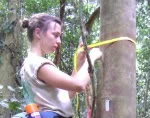People like to say ‘blood is thicker than water’. But plants may actually treat ther siblings better than many of us: although lacking in blood, scientists have found that plants not only recognize family, but respect their space.
The first study to discover that plants were able to recognize siblings was conducted in 2007 on the sea rocket, a seashore plant. In the study, conducted by Susan Dudley of McMaster University in Hamilton, Ontario, researchers found that the plants’ roots would not compete with their siblings but instead would ‘play nice’ and share the space. Now, new research published in Communicative & Integrative Biology shows just how plants, lacking vision and smell, recognize which nearby individuals are familial and which are not.
Harsh Bais, assistant professor of plant and soil sciences at the University of Delaware, painstakingly studied the reactions of wild Arabidopsis thaliana, a common flowering plant that has become a favorite for researchers.
But how do you discover how plants communicate? “Plants have no visible sensory markers, and they can’t run away from where they are planted,” Bais says. “It then becomes a search for more complex patterns of recognition.”
Extracting chemical secretions from the roots (known as exudates) of his study plants, Bais systematically exposed seedlings to the secretions of their siblings, of strangers, and even of themselves.
The study found that when individual plants were exposed to the root secretions of strangers they pushed out with greater lateral root formation, in a sense actively competing with the stranger for room. When Bais inhibited the root secretions, however, this aggressive push outward stopped. The method then by which plants recognize siblings, Bais discovered, is through contact with root secretions. Something in these secretions tells the plant whether it is related or not.
Bais also found that plants growing adjacent to strangers are shorter than if they are grown next to siblings, since strangers place excess energy into their roots. Bais said that he observed sibling plants allowing their leaves to touch and intertwine, while unrelated plants will grow rigidly and avoid physical contact.
Related articles
Will tropical trees survive climate change?, an interview with Kenneth J. Feeley

(09/24/2009) One of the most pressing issues in the conservation today is how climate change will affect tropical ecosystems. The short answer is: we don’t know. Because of this, more and more scientists are looking at the probable impacts of a warmer world on the Earth’s most vibrant and biodiverse ecosystems. Kenneth J. Feeley, tropical ecologist and new professor at Florida International University and the Center for Tropical Plant Conservation at the Fairchild Tropical Botanic Garden, is conducting groundbreaking research in the tropical forests of Peru on the migration of tree species due to climate change.
New carnivorous plant big enough to swallow a rat
(08/11/2009) A newly discovered carnivorous plant in the central Philippines is large enough to catch a rat, according to a story by the BBC. Nepenthes attenboroughii, named after naturalist and broadcast David Attenborough, is a member of the pitcher plant family, so-called because it is shaped like a large pitcher. The plant preys on insects and animals that fall into its gaping maw.
Plant communities changing across the globe, says scientist Sasha Wright

(03/29/2009) Having studied plant communities across three continent and within widely varied ecosystems—lowland tropics, deciduous forests, grasslands, and enclosed ecosystems on hill-tops—graduate student Sasha Wright has gained a unique understanding of shifts in plant communities worldwide as they respond to pressures from land use and global climate change. “Plant communities are certainly changing,” Wright told Mongabay.com in a March 2009 interview. “These changes are undoubtedly affected by an increased occurrence of extreme weather events, temperature fluctuations, atmospheric CO2 concentrations, human land use, and in some cases urbanization of populations.”







